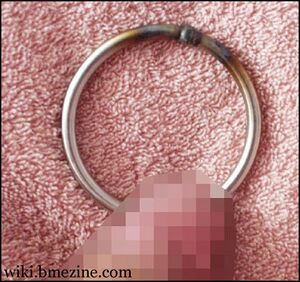Permanent Piercing: Difference between revisions
(Created page with "<html><div class="mw-content-ltr" dir="ltr" id="mw-content-text" lang="en"><div class="thumb tright"><div class="thumbinner" style="width:182px;"><a class="image" href="/index.php?title=File:PermanentPiercing.jpg"><img alt="" class="thumbimage" height="169" src="/images/thumb/e/e2/PermanentPiercing.jpg/180px-PermanentPiercing.jpg" width="180"/></a> <div class="thumbcaption"><div class="magnify"><a class="internal" href="/index.php?title=File:PermanentPiercing.jpg" title=...") |
(Page conversion via llm-mediawiki-rev -jwm) |
||
| Line 1: | Line 1: | ||
[[File:PermanentPiercing.jpg|thumb|right|Welded [[PA]] [[Chastity Piercing]] (the size of the ring makes penetrative sex difficult if not impossible)]] | |||
A permanent piercing is a piercing which cannot be removed without either surgical excision (i.e. cutting it out) or by destroying the jewelry (i.e. cutting apart the jewelry so it can be removed). Most commonly this is achieved by welding, soldering, or otherwise permanently bonding the jewelry closed. If the method involves heat, a heat sink (or even vice grips) ''must'' be used in order to avoid damaging the piercing. | |||
Other forms of permanent piercing include [[transdermal implants]], [[chain piercings]], and even standard piercings which can not be removed without the use of specialized tools (for example, [[CBRs]] larger than 4[[ga]] are almost impossible to remove for most people without the aid of [[ring opening pliers]]). | |||
While most forms of permanent piercings are not very difficult to remove, they should, of course, still be taken quite seriously because should there be a need to remove them (a doctor's visit, emergency surgery, and so on), their nature can complicate matters, especially if it is of the type that can only be removed by excision (transdermals and chain piercing primarily). | |||
Latest revision as of 09:30, 17 September 2023

A permanent piercing is a piercing which cannot be removed without either surgical excision (i.e. cutting it out) or by destroying the jewelry (i.e. cutting apart the jewelry so it can be removed). Most commonly this is achieved by welding, soldering, or otherwise permanently bonding the jewelry closed. If the method involves heat, a heat sink (or even vice grips) must be used in order to avoid damaging the piercing.
Other forms of permanent piercing include transdermal implants, chain piercings, and even standard piercings which can not be removed without the use of specialized tools (for example, CBRs larger than 4ga are almost impossible to remove for most people without the aid of ring opening pliers).
While most forms of permanent piercings are not very difficult to remove, they should, of course, still be taken quite seriously because should there be a need to remove them (a doctor's visit, emergency surgery, and so on), their nature can complicate matters, especially if it is of the type that can only be removed by excision (transdermals and chain piercing primarily).